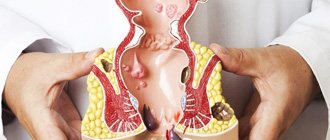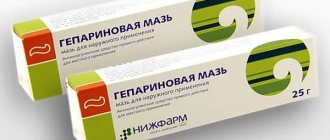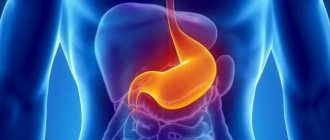Anal fissure is a fairly common problem that affects not only adults. Sometimes children suffer from pathology. It is important to take measures as soon as possible to help the child, because the problem brings great discomfort to the baby. The article will help you understand the main causes and factors for the appearance of anal fissures in children, as well as the diagnosis and treatment of these abnormalities.
Anal fissures are tears in the intestinal mucosa, manifested by the appearance of wounds on the rectum of varying lengths and depths. The problem is quite rare in children, but when it occurs, children suffer much more than adults. The disease affects children of all ages, regardless of the gender of the child.
The main factors that provoke the development of anal fissures in children
The main cause of anal fissures in children is constipation caused by poor diet. Overexertion of the large intestine leads to ruptures of the mucous membrane. In addition, diseases of the upper and lower gastrointestinal tract can also cause constipation, which contribute to poor functional ability of the rectum, which causes wound surfaces.
Also, the causes of anal fissures are inflammatory diseases of the rectum - colitis, proctitis. They contribute to the appearance of an inflamed area, which is easily injured by feces when passing through them during bowel movements. In addition, during the inflammatory process, the blood supply to the intestinal area is disrupted, as a result of which it is depleted, causing cracks to form on it.
Parasites, which are often present in a child’s body, can also cause a violation of the integrity of tissues in the rectum. Secretions of helminthic infestations and pinworms contain substances that can destroy the intestinal walls, leading to the appearance of wound surfaces and inflammatory areas on it.
In addition to the reasons presented above, today there are a number of factors that can become the main link in the development of anal fissure:
- Poor or poor hygiene – excessive use of soap or poor quality of washing the baby can be the main impetus for the appearance of anal fissures;
- Anomalies in the development of the large intestine;
- Allergic reactions;
- Poor diet and quality of nutrition – children who receive little fiber suffer from hard stool that cannot pass through their colon.
To find out the exact cause, as well as undergo additional examination, you should contact your pediatrician. This will allow you to begin comprehensive treatment to completely eliminate the disease.
General recommendations
It is possible to eliminate rectal fissures in children by following the following recommendations:
- organize meals appropriate for the baby’s age. He should eat often, in small portions. It is recommended to include a lot of vegetables, fruits, and dairy products in the menu;
- remove spicy, smoked foods from your baby’s diet. It is recommended to limit the consumption of confectionery products, white bread, and rolls as much as possible;
- follow the doctor’s instructions to eliminate the causes of damage to the mucous membrane;
- increase the amount of fluid consumed. It is not advisable to give your baby juices or sweet compotes. Boiled or bottled water is suitable for drinking;
- After bowel movements, cleansing the anus with water is encouraged. After hygiene procedures, it is recommended to treat the anus with baby cream. It will moisturize the skin and prevent cracking.
During treatment it is necessary to strictly adhere to the diet
Types of anal fissures in children
A fissure in the anus in a child, as in adults, can develop in two forms - acute and chronic, depending on the time of the process and the ability of tissues to regenerate damaged areas in the rectal area.
- The acute form of anal fissures in children is characterized by a newly formed wound surface with smooth edges and shallow depth. Acute stage fissures usually heal quickly, but their presence brings great discomfort, pain and a feeling of fear of the toilet to the child.
- Chronic form. The stage of chronic formation of anal fissures in children is very rare and is associated mainly with improperly treated acute forms. This stage is characterized by the appearance of scars and bumpy surfaces on the rectal mucosa. The child experiences a burning, continuous pain that bothers him almost constantly, intensifying after going to the toilet. As the chronic stage develops, children develop a great fear of the potty and toilet, so they cry and refuse to poop.
Anal fissures develop gradually, with an increase in the clinical picture and symptoms, so the form of pathology can be identified after a thorough examination in the hospital.
Symptoms of the disorder
A crack in the anus can be noticed by the baby’s changed behavior. Infants and toddlers constantly cry, scream, cannot lie in one place, even twitching and tossing while sleeping. The screaming especially intensifies after going to the toilet.
The wound surface in the child’s bottom does not show external clinical signs, however, a problem can be suspected by the fact that the baby constantly pulls his hand towards the anus, he is restless and irritated. In addition, symptoms of fissures in the anus in children may include:
- The baby stops agreeing to sit on the potty, cries if he is forced to sit on the potty, and refuses to poop. Against this background, a spasm of the sphincter occurs, which complicates the problem and leads to increased wound formation;
- After the baby goes to the toilet screaming, you can see streaks of blood in the stool, which indicates that the fissure is bleeding;
- Sometimes fissures can manifest as inflammation and redness around the anus;
- Against the backdrop of refusing to defecate, children begin to suffer from constipation, which only complicates the situation. During the normal course of the process, the child's stool is a paste-like structure, even in color and consistency.
- Older children may complain of pain in the anus when walking or performing motor functions,
- Some children try to relieve pain by taking a forced position, while they freeze and try not to move for no particular reason.
It is important to understand that children who are able to talk about their problem and understand the essence of the disease may remain silent about their ailments, therefore, when changing the child’s behavior, it is important to pay attention to changes in movements and behavior. This will make it possible to find out about the presence of the disease and promptly contact a pediatrician for diagnosis and treatment.
Diagnostic measures
Diagnosis of anal fissures consists of a digital examination of the rectum, during which the doctor can assess the condition of the mucous membrane, the size and structure of the tissues damaged as a result of the formation of the wound surface. In addition, the doctor will be able to determine the exact localization of the inflammatory process.
Digital examination is carried out using local anesthesia. Novocaine, injected into the rectum, allows you to relax the sphincters and rationally carry out the examination, without bringing additional suffering to the child.
Diagnostic procedures allow for differential diagnosis of pathology with disorders such as hemorrhoids, paraproctitis, colitis, and neoplasms in the rectum.
Diagnostics
In cases where the above symptoms appear, it is necessary to show the child to a pediatrician or pediatric surgeon as soon as possible. Establishing the correct diagnosis requires an integrated approach and includes:
- a detailed survey of the parents of a sick child regarding the first time of appearance of clinical manifestations;
- studying the medical history and life history of a small patient;
- performing a thorough objective examination of the perianal area and digital examination of the rectum. The second procedure is necessary to assess the functioning of the anal sphincter;
- laboratory tests of blood and feces - to identify signs of an inflammatory or infectious process in the body, as well as for the possible detection of worms or parasites;
- instrumental examinations, including irrigoscopy, anoscopy, ultrasound, sigmoidoscopy and colonoscopy.
Colonoscopy procedure
Only after an examination can the doctor decide how to treat the patient’s illness.
Treatment of fissures in the anus in children
After making an accurate diagnosis, the pediatrician chooses the principle of treatment and the method of eliminating the problem, based on the child’s age and stage of the disease. The basic principles of therapeutic measures are based on symptomatic and anti-inflammatory therapy of the disease. Equally important is a balanced diet, which plays a big role in the rapid healing of wounds.
Diet
An important stage in the treatment of fissures in the anus is diet therapy aimed at restoring the child’s stool and diluting stool so that it passes through the large intestine more easily.
The diet of breastfed infants must be followed by the mother of the child so that unnecessary substances are not transferred through milk. Formula-fed babies need to change the formula to another, which does not contain a large amount of lactose, as well as bifidobacteria. Your doctor can help you choose the right product for your baby.
Diet therapy consists of reducing the consumption of proteins and fats, increasing the consumption of plant and vegetable foods that contain large amounts of vitamins and minerals, and are easily digestible in the body and do not affect the thickening of stool.
Eating meat and fish should be regularly included in the diet, but it is important to understand that when treating anal fissures in children, these foods should be eaten in small pieces no more than once a day.
Do not forget to drink the daily dose of liquid, which should be at least 1-1.5 liters per day. Normalizing nutrition with the right choice of diet will help the child quickly solve the problem of hard stool, and will also help speed up the process of tissue regeneration in the rectum.
Conservative
The main role in eliminating the problem is played by conservative methods of eliminating the problem with the help of medications and procedures. The main task to be solved when prescribing therapeutic agents to a child is to eliminate the cause of the disorder and influence the wound in the safest ways to cause the baby a minimum of discomfort.
Most often, ointments and rectal suppositories are used in the treatment of anal fissures, which have wound healing, anti-inflammatory and analgesic effects. The most popular candles today are:
- Calendula against inflammation of the walls of the anus - suppositories help to quickly eliminate swelling in the anus and ensure blood flow to the wound, due to which the crack heals quickly,
- Sea buckthorn suppositories help eliminate bleeding, relieve inflammation and swelling in the wound. For children under one year of age, half a suppository is used, cut parallel to the axis of the suppository;
- Propolis suppositories are an effective remedy that helps fight very severe inflammation and itching in the anal fissure area.
- Aurobin - rectal suppositories with a healing effect. Allowed for use only after 1 year of life.
In addition, children over 6 years old can use Salofalk suppositories, and from 12 years old, Relief suppositories are suitable for the treatment of anal fissures.
Drug therapy methods also include the local use of wound-healing and anti-inflammatory ointments, such as Levomekol, Ultraproct and Nitroglycerin ointment, which eliminate sphincter spasm, help the wound regenerate cells at a faster rate, as well as relieve pain and relieve irritation and itching in the anal area.
It is important to understand that the introduction of suppositories and the use of ointments is possible only after consultation with a doctor, because the child’s body is not predictable, it can give an allergic reaction to any drug, in addition, many drugs have side effects, which also limits their use.
Surgical
Surgical treatment of anal fissures in children is used extremely rarely, in the case of a chronic process with poor results of conservative therapy.
Surgery is performed under anesthesia. The patient undergoes excision of the edges of the wound in order to refresh the wound surface and make the wound in the acute stage. After this, stitches may be placed, but most often the crack is left in its normal state to heal on its own.
The operation can be performed as with a regular scalpel, but today special radio wave sensors are more often used, which cause the least trauma and do not leave bleeding. In addition, operations to excise anal fissures can be performed with a laser, which has many advantages over other types of surgical interventions.
After surgery to excise the wound, conservative therapy is required, which allows the already acute form of a fissure in the anus to heal quickly and painlessly.
Symptoms
An anal fissure causes severe pain in most cases. Sometimes patients stop consciously going to the toilet because they experience unbearable pain. As a result, the stool hardens, the mucous membrane is further irritated and ruptured. A vicious circle arises, chronic diseases can develop that can cause serious complications.
Constipation is the main risk factor for the development of cracks of varying severity
A crack in the anal mucosa causes very strong, burning and, above all, cramping pain during defecation. If the perianal tissue is damaged, traces of blood may appear on the stool or toilet paper.
Most patients report severe itching and burning around the anus. The damaged areas bleed continuously, so patients need to change their bed linen frequently. Some patients are unable to sit still due to pain.
The discomfort that many people experience leads to involuntary spasm of the sphincter. Cramps and pain may last for several hours. In the area of the anal tissue there are many sensory nerve endings, the irritation of which causes pain attacks. Pain is directly related to bowel movements.
The more the mucous membrane is irritated and the tissue is damaged, the stronger and longer the pain. The pain can become so severe and unbearable that patients are no longer able to sit on their buttocks. Patients spend a lot of time standing or lying down to avoid pain.
Folk remedies
A good result in the treatment of anal fissures in children is achieved by the combined effect of medications and traditional medicine.
Microclysters with herbal decoctions
Microenemas made from herbal decoctions - chamomile, string, calendula - have an excellent effect for eliminating problems with constipation. To carry out this procedure, you should insert a pear-shaped balloon filled with a solution into the intestine and quietly squeeze out the contents into the rectal area, then, without releasing the deflated bulb, remove it from the intestine. It is important to do enemas carefully so as not to injure the already wounded surface of the mucous membrane.
In addition, some advise doing enemas with a weak solution of potassium permanganate, but you should understand that this can be dangerous, because it is easy to overdo it with potassium permanganate, which means it can cause even more harm.
Baths to reduce symptoms
Reducing the symptoms of fissures in the anus is very important in order to calm and not further injure the baby. In this case, baths with herbs that have healing effects have a good analgesic and anti-inflammatory effect.
The most common are baths with Chamomile and calendula, but herbs such as celandine, oak bark, yarrow, string, and nettle mint are well suited. These herbs have anti-inflammatory, healing and relaxing effects.
Baths with herbal infusions will help the child relieve pain from the crack, as well as reduce other manifestations of the problem, improving the condition and mood of the baby. The main rule of therapeutic baths for children is the temperature of the water, which should be warm, but not hot, so as not to burn the baby.
To take a bath, the patient should be placed in the prepared solution for 10-15 minutes so that the baby’s legs and butt are completely hidden by water. After holding it for some time, you should dry the little patient’s body and dress him in a warm suit or pajamas.
Complications
If the approach to treatment is not correct, or timely seeking medical help, as well as in the case of chronic development of the disease, there is a high risk of developing complications of anal fissures.
The most dangerous diseases are:
- Paraproctitis and rectal fistulas;
- Chronic constipation;
- Colon infections;
- Neoplasm in the intestine;
- Ulcerative formations in the intestines;
- Sepsis;
- Impaired elasticity of the tissues of the anus, as a result of which it is almost impossible to remove feces naturally. This condition is called Pectenosis, it is not curable.
Complications are difficult to treat. They cause a lot of agony and pain to patients, so when a problem occurs, it is important to begin treatment in a timely manner.
Herbal baths will relieve the condition
To relieve the inflammatory process and quickly heal anal fissures, babies can be bathed in warm herbal baths. This remedy has been known since ancient times and has been successfully used by more than one generation. The main thing is that the child does not develop allergies.
The following herbs are suitable for preparing medicinal decoctions:
Brew any of these components (1 tablespoon of raw material per 200 ml of water) and pour into a baby bath or wide basin. Place the child there so that the butt is completely immersed in water. Make sure that the water remains warm and the duration of the procedure does not exceed 10 minutes. After finishing the therapeutic bath, dress the child in clean clothes.
It is advisable to add potassium permanganate to the bath - stir it with water in a separate container, and then carefully pour it into the broth. Otherwise, manganese crystals may burn the baby's skin.
Prevention
Preventive measures will help not only to avoid the child getting sick, but also to prevent the condition from worsening with an existing anal fissure. The main methods of prevention are:
- Rationalization of nutrition by eating foods containing the optimal amount of proteins, fats and carbohydrates;
- Compliance with drinking regime;
- Rational use of cleansers and soaps so as not to dry out the rectal mucosa;
- Timely treatment of gastrointestinal pathologies;
- It is necessary to control the baby's bowel movements, its regularity and the quality of the stool;
- you need to be active, for this you should diversify games and walks;
- Wear your child only high-quality cotton underwear that does not irritate the baby’s skin;
- Strict adherence to all doctor’s instructions and high-quality treatment of an existing crack to prevent a chronic process.
To summarize, we should conclude that an anal fissure in a child is a terrible disease that causes suffering and pain to the baby. If you suspect a pathology and the first signs of abnormality appear, you should immediately see a doctor for consultation. After all, the speed of treatment and the quality of life of a small patient depend on the quality and speed of the measures taken.











